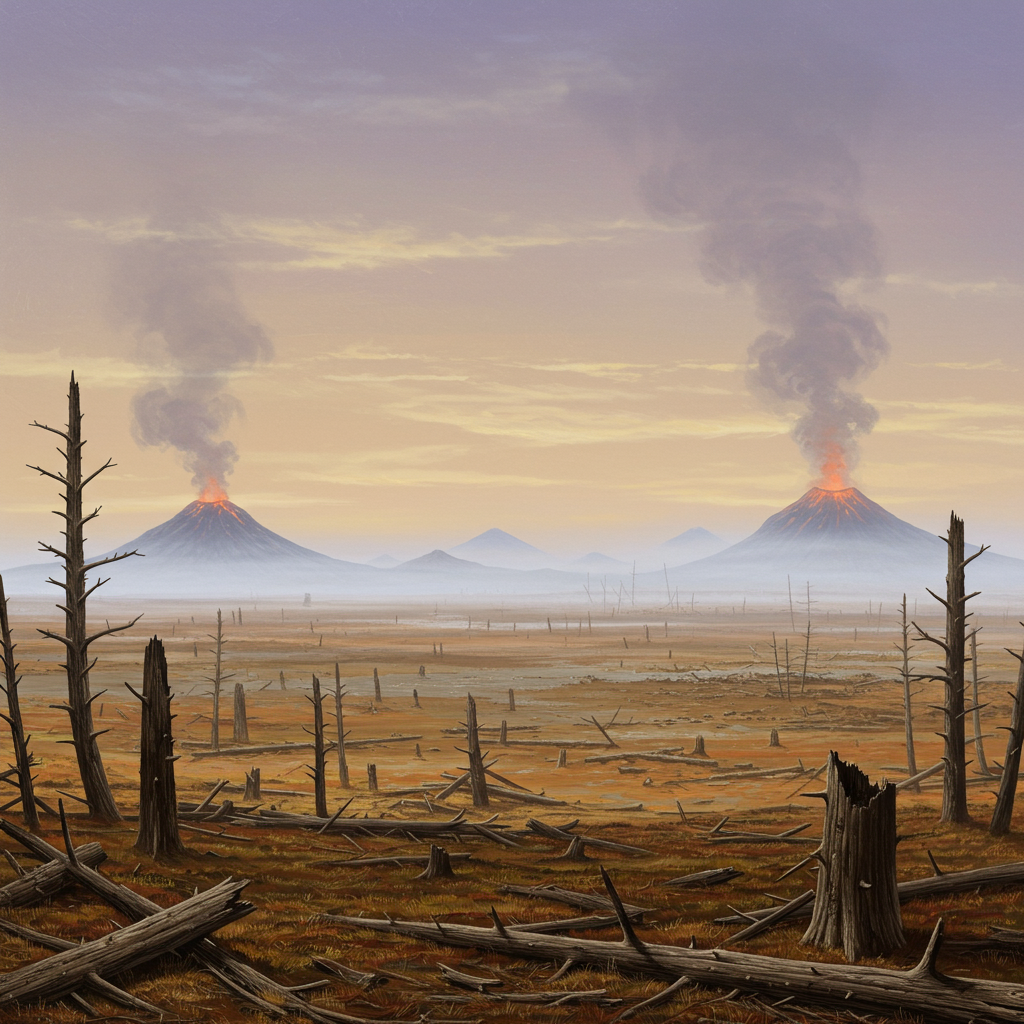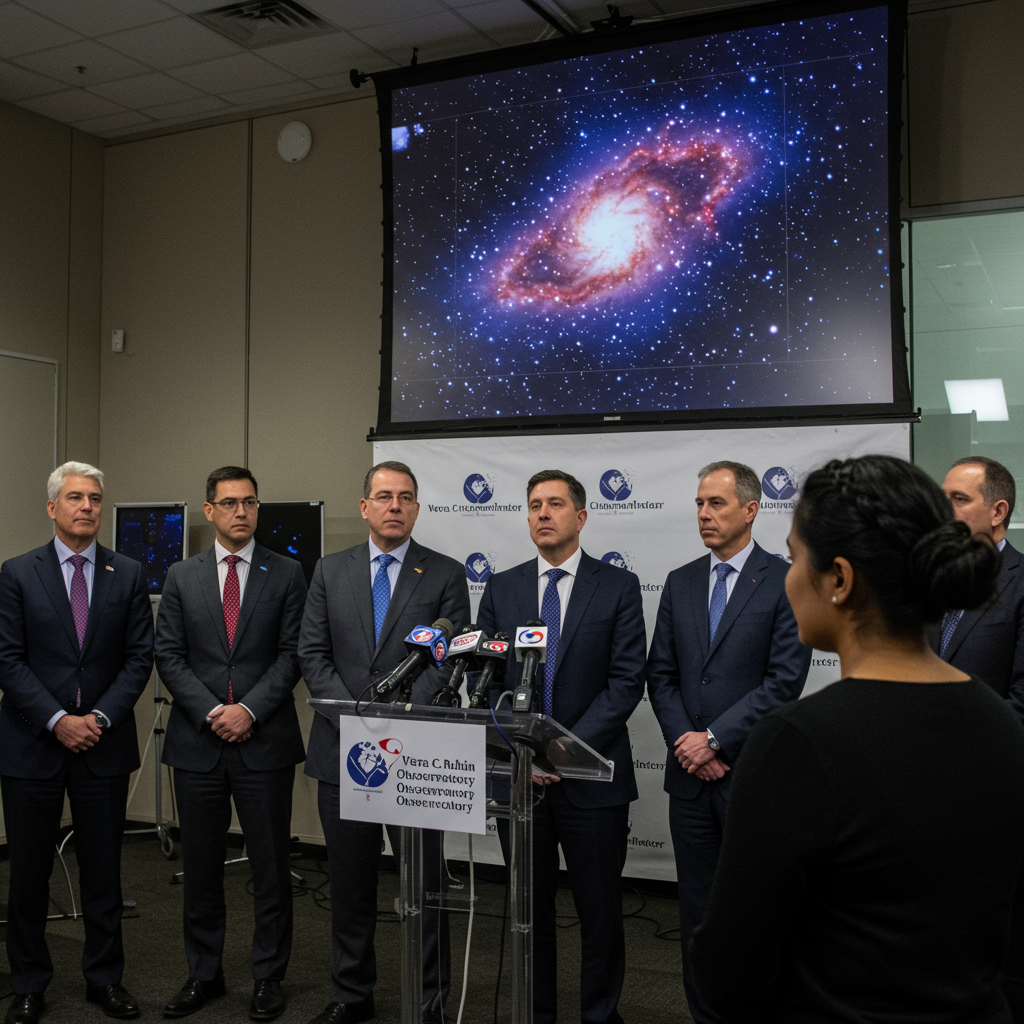The Permian–Triassic Mass Extinction, Earth’s most severe crisis, saw vast life disappear around 252 million years ago. While giant volcanic eruptions in Siberia triggered this catastrophe with intense initial warming, a major scientific puzzle remained. Why did brutal super-greenhouse conditions persist for nearly five million years after the main volcanic pulse subsided? New research, published in Nature Communications, points to a dramatic and prolonged collapse of global plant life as the surprising culprit. This immense loss of vegetation crippled Earth’s natural cooling mechanisms, trapping heat for millions of years and creating a uniquely hostile environment.
Earth’s Deadliest Crisis and a climate Mystery
The period from the late Permian into the Early Triassic (~252–247 million years ago) was marked by extreme environmental stress. The Permian–Triassic Mass Extinction (PTME) itself wiped out an estimated 81–94% of marine species and 89% of terrestrial animal genera. Scientists widely agree that massive volcanic activity from the Siberian Traps ignited this crisis. These eruptions released enormous amounts of greenhouse gases, primarily carbon dioxide, causing rapid global warming. Evidence like a significant drop in carbon isotope ratios in carbonate rocks supports this major disruption to the global carbon cycle over a relatively short period (tens to hundreds of thousands of years).
However, standard Earth system processes should have counteracted this carbon surge. Natural feedbacks, such as accelerated silicate weathering (where rocks react with CO2 and water to remove carbon from the atmosphere) and increased burial of organic carbon, typically work to restore atmospheric CO2 and temperature levels. These processes are expected to stabilize the climate within roughly 100,000 years after a major carbon injection. The fact that intense hothouse conditions endured for five million years throughout the Early Triassic presented a significant scientific challenge that traditional explanations struggled to fully address.
The Hypothesis: Vegetation Collapse Amplified Warming
Previous ideas to explain the prolonged warmth included suggestions of reduced erosion limiting weatherable material or rapid “reverse weathering” in the oceans. While possibly contributing, these hypotheses didn’t convincingly explain why such conditions would last precisely five million years before recovering in the Middle Triassic.
This new study explored an alternative mechanism, one directly linked to the timeframe of the extreme heat: a dramatic and extended reduction in terrestrial plant biomass. The hypothesis posits that the PTME caused a massive die-off of plants, particularly in warm, low-latitude regions. Plants play a critical role in regulating climate by:
- Sequestering Carbon: Photosynthesis draws CO2 from the atmosphere, converting it into organic matter. Burial of this organic matter (like in peat or sediments) locks carbon away.
- Enhancing Weathering: Plant roots and microbial activity in soils significantly speed up the chemical weathering of rocks, a key long-term process for removing atmospheric CO2.
- Organic Carbon Burial: The total estimated global NPPL scaled the amount of terrestrial organic carbon buried in sediments.
- Chemical Weathering: Local plant productivity enhanced the rate of continental silicate weathering. A higher plant cover meant faster weathering and more CO2 removal. The model included the well-established CO2 fertilization effect, where higher CO2 levels can boost plant growth (and thus productivity and weathering enhancement), but this effect has limits.
A widespread and prolonged loss of vegetation would weaken both these carbon removal pathways, potentially allowing CO2 levels and global temperatures to remain exceptionally high for millions of years. The geological record already noted a “coal gap” during the Early to Middle Triassic, indicating a severe disruption in the accumulation of plant material that forms coal deposits. This provided a key piece of initial evidence for widespread plant loss.
Reconstructing the Ancient Plant World
To test this hypothesis, researchers from institutions including the University of Leeds and Nanjing Institute of Geology and Palaeontology undertook a comprehensive effort to map ancient plant life. They combined data from fossil occurrences and geological indicators of climate.
Piecing Together Fossil Clues
The team compiled a vast database of plant macrofossil and palynology (spore and pollen) data spanning the late Permian to the Middle Triassic globally. A crucial step involved “normalizing” the fossil data. This is necessary because different parts of the same ancient plant (e.g., a leaf, a seed, a trunk) are often given different scientific names in the fossil record. Normalization helps avoid overcounting species and provides a more accurate picture of original plant diversity.
Reading the Ancient Landscape
Beyond just counting fossils, the scientists analyzed plant functional traits preserved in macrofossils. Features like plant height, leaf size, vein density, and cuticle thickness provide clues about how these ancient plants functioned, their water needs, and their potential productivity. By linking these traits to climate zones, they could infer the types of plant communities that existed across different regions. Lithological indicators – clues found in the rocks themselves, such as the presence of coal (indicating lush, wet conditions) or evaporites (indicating aridity) – helped constrain climate zones and refine the vegetation maps. Occurrences of terrestrial tetrapod (four-limbed vertebrate) fossils also served as proxies for the existence of vegetation, as these animals depended on plants for food and habitat.
Mapping the Global Collapse
Using statistical methods and extrapolation across corresponding climate zones, the researchers created spatio-temporal maps of vegetation distribution. These maps revealed a devastating loss of plant life, particularly in low-to-middle latitudes (-45°N to 45°S), during the PTME. Tropical and subtropical vegetation, including tall lowland forests (potentially up to 50m high), were hit hardest. Fossil evidence showed an 86% extinction rate for macrofossil species in these low-mid latitudes, compared to 66% in high latitudes. The complex, towering forests were largely replaced by low-diversity communities dominated by small herbaceous plants (only 0.05 to 2m tall). This loss of biomass is directly reflected in the “coal gap” observed globally; the suitable environments for peat formation still existed, but the plants needed to create the peat did not.
Intriguingly, the maps showed a reversal of the modern latitudinal diversity gradient. Before the PTME, low latitudes had the highest plant diversity and productivity, similar to today’s rainforests. After the extinction, high-latitude regions became relative refuges, supporting more diverse plant communities than the devastated equatorial zones. This pattern is also seen in terrestrial animal fossils (“Dead Zone” near the equator), suggesting that climate stress—likely intense heat and seasonal aridity amplified in low-to-mid latitudes by the volcanic emissions—was a primary driver of this widespread terrestrial extinction.
Quantifying the Impact: Productivity and Modeling
To estimate the scale of the plant productivity collapse, the researchers used modern plant functional types as analogs for the ancient biomes they reconstructed. By comparing the reconstructed ancient ecosystems to similar modern ones, they could estimate Net Primary Productivity on Land (NPPL)—the total amount of organic carbon produced by plants each year.
Their estimates show a staggering decline in global terrestrial productivity. NPPL dropped from around 54.4–62.5 Petagrams of Carbon per year (Pt C/yr) in the late Permian to a low of approximately 13.0–19.7 Pt C/yr during the Early Triassic Induan stage. This represents a loss of roughly 70% of Earth’s land-based plant productivity. Productivity gradually began to recover in the subsequent Olenekian stage (~25.0–32.2 Pt C/yr), accelerating significantly in the Middle Triassic Anisian stage (~53.8–63.5 Pt C/yr), coinciding with the reappearance of tropical biomes and coal deposits.
Modeling the Ancient Atmosphere
To determine if this collapse in vegetation could explain the prolonged super-greenhouse, the researchers incorporated their productivity reconstructions into the SCION Earth Evolution Model, a climate-biogeochemical model. The model was designed to link climate processes with the global carbon cycle.
In the model, the fossil-based plant productivity maps influenced two key Earth system processes:
The model also included the initial CO2 pulse from the Siberian Traps to simulate the extinction trigger.
The Modeled Results: A Hothouse Explained
The results from the SCION model provided compelling support for the vegetation collapse hypothesis.
The Control vs. The Plant Scenario
A control run of the model, which included the Siberian Traps emissions but kept plant productivity constant (like a world without the PTME plant extinction), failed to replicate the prolonged warming. In this scenario, CO2 levels and temperatures spiked briefly due to the volcanism but then declined relatively quickly within a few hundred thousand years, as standard Earth system feedbacks kicked in. This didn’t match the geological evidence of a five-million-year super-greenhouse.
However, when the reconstructed decline and recovery of vegetation were included in the model, the results dramatically changed. The significant reduction in terrestrial organic carbon burial, combined with the substantial weakening of silicate weathering due to the loss of plant cover, caused atmospheric CO2 levels to stabilize at extremely high concentrations—around 7000 ppm—for approximately five million years. This sustained high CO2 resulted in prolonged high equatorial surface temperatures, reaching up to 33-34°C in the model. These results align remarkably well with temperature estimates derived from geological proxies for the Early Triassic. The model run with vegetation collapse also produced a better fit to the geological record of carbon isotope ratios (δ13C) during this period.
Weathering’s Outsized Role
The modeling revealed that, in this scenario, the reduction in continental silicate weathering intensity (driven by decreased plant productivity) had a greater impact on maintaining high atmospheric CO2 than the direct effect of a decline in organic carbon burial. While less burial did increase CO2, the model included feedbacks that somewhat compensated for this (like shifting nutrients to the ocean, potentially boosting marine burial). The disruption of the plant-enhanced weathering process, however, was a powerful lever in keeping CO2 levels elevated for such a long time.
The model further demonstrated how the gradual recovery of terrestrial ecosystems, starting in the Olenekian and accelerating in the Middle Triassic Anisian, would have progressively strengthened carbon removal processes. This recovery matches the geological timing of cooling and the return to more diverse plant communities and coal-forming ecosystems observed in the fossil record.
Why This Matters: Thresholds and Future Lessons
This study provides quantitative evidence that the massive and prolonged loss of terrestrial vegetation during the Early Triassic was the primary driver of the sustained five-million-year super-greenhouse climate. It highlights the critical role of plants in regulating Earth’s climate system over geological timescales, particularly through their influence on chemical weathering and carbon burial.
The findings underscore a crucial concept: the existence of thresholds within the Earth system. Beyond a certain point, warming can trigger severe vegetation die-back. This loss then creates a positive feedback loop, where reduced plant carbon sinks (weathering and burial) further amplify the initial warming. This study shows that such positive feedbacks can lock the Earth system into prolonged adverse climate states for millions of years, with profound consequences for global ecosystems. The slow, painstaking recovery of plant life was essential to finally breaking out of this hot state. This ancient event serves as a powerful case study, demonstrating how disrupting natural biological carbon cycles can have devastating, long-lasting impacts on Earth’s climate.
Frequently Asked Questions
Why did the extreme heat last so long after the Permian-Triassic extinction volcano eruptions stopped?
While Siberian Traps volcanism initially triggered the warming, the standard geological processes that would normally remove carbon dioxide from the atmosphere (like rock weathering and carbon burial) were severely weakened. New research indicates this weakening was primarily caused by the catastrophic, prolonged collapse of global plant life. Plants significantly enhance these cooling processes, so their loss crippled Earth’s ability to naturally reduce atmospheric CO2 and temperatures for approximately five million years.
How did scientists determine the distribution and productivity of ancient plants during this time?
Researchers compiled extensive fossil data (macrofossils, spores, pollen) from around the world and normalized it to account for biases. They analyzed plant functional traits (like leaf size and plant height) and used lithological clues (like coal or evaporite deposits) along with animal fossil data to reconstruct ancient plant communities and climate zones. By comparing these reconstructed ecosystems to similar modern ones, they estimated the ancient Net Primary Productivity (NPPL) and how it changed over millions of years.
What can the Early Triassic super-greenhouse event teach us about modern climate change?
This ancient event reveals a critical Earth system threshold and a dangerous positive feedback loop. It shows that beyond a certain level of warming or stress, widespread vegetation die-back can occur. This loss then reduces natural carbon sequestration (weathering and burial), which in turn accelerates warming. This mechanism can potentially lock the planet into prolonged periods of extreme heat. The Early Triassic serves as a stark reminder of how sensitive Earth’s climate is to changes in its biological carbon pumps and the long-term risks of disrupting these natural systems.
Word Count Check: 1189




